Monitoring and Optimization of Potato Growth Dynamics under Different Nitrogen Forms and Rates Using UAV RGB Imagery
Abstract
:1. Introduction
2. Materials and Methods
2.1. Experimental Sites and Design
2.2. UAV Image Acquisition and Preprocessing
2.3. Canopy Cover Extraction and Canopy Development Curve Fitting
2.4. Determination of Net Photosynthetic Rate at the Leaf Level
2.5. Determination of Total Plant Dry Weight and Tuber Yield
2.6. Data Analysis
3. Results
3.1. Parameters of Potato Canopy Development under Different Nitrogen Treatments
3.1.1. Primary Parameters
3.1.2. Secondary Parameters
3.2. Relationship between Integral Area under Canopy Development Curve and Plant Dry Matter Accumulation
3.3. Relationship between Tuber Yield and Model Parameters
4. Discussion
4.1. Factors Affecting Canopy Development Parameters
4.2. Factors Affecting Plant Dry Matter Accumulation
4.3. Relationship between Model Parameters and Tuber Yield
5. Conclusions
Author Contributions
Funding
Data Availability Statement
Conflicts of Interest
References
- De Jong, H. Impact of the Potato on Society. Am. J. Potato Res. 2016, 5, 415–429. [Google Scholar] [CrossRef]
- Tiwari, J.K.; Plett, D.; Garnett, T.; Chakrabarti, S.K.; Singh, R.K. Integrated Genomics, Physiology and Breeding Approaches for Improving Nitrogen Use Efficiency in Potato: Translating Knowledge from Other Crops. Funct. Plant Biol. 2018, 45, 587. [Google Scholar] [CrossRef] [PubMed]
- Saluzzo, J.A.; Echeverría, H.E.; Andrade, F.H.; Huarte, M. Nitrogen Nutrition of Potato Cultivars Differing in Maturity. J. Agron. Crop Sci. 1999, 183, 157–165. [Google Scholar] [CrossRef]
- Alva, L. Potato Nitrogen Management. J. Veg. Crop Prod. 2004, 10, 97–132. [Google Scholar] [CrossRef]
- Huangfu, L. Effects of Water Supply and Nitrogen Forms on Nitrogen Uptake and Utilization, Yield and Quality of Potato. Master’s Thesis, Jilin Agricultural University, Changchun, China, 2023. [Google Scholar]
- Ayyub, C.; Haidar, M.; Zulfiqar, F.; Abideen, Z.; Wright, S. Potato Tuber Yield and Quality in Response to Different Nitrogen Fertilizer Application Rates under Two Split Doses in an Irrigated Sandy Loam Soil. J. Plant Nutr. 2019, 42, 1850–1860. [Google Scholar] [CrossRef]
- Lorenz, O.A.; Bishop, J.C.; Hoyle, B.J.; Zobel, M.P.; Minges, P.A.; Doneen, L.D.; Ulrich, A. Potato Fertilizer Experiment in California. Calif. Agric. Exp. Stn. Bull. 1954, B0744, 7. [Google Scholar]
- Wang, S. Effects of Different Nitrogen Forms on Potato Growth and Soil Microecology. Master’s Thesis, Hunan Agricultural University, Changsha, China, 2021. [Google Scholar]
- Kukal, M.S.; Irmak, S. Comparative Canopy Growth Dynamics in Four Row Crops and Their Relationships with Allometric and Environmental Determinants. Agron. J. 2019, 111, 1799–1816. [Google Scholar] [CrossRef]
- Khan, M.S.; Struik, P.C.; van der Putten, P.E.; Jansen, H.J.; van Eck, H.J.; van Eeuwijk, F.A.; Yin, X. A Model-Based Approach to Analyse Genetic Variation in Potato Using Standard Cultivars and a Segregating Population. I. Canopy Cover Dynamics. Field Crops Res. 2019, 242, 107581. [Google Scholar] [CrossRef]
- Aliche, E.B.; Oortwijn, M.; Theeuwen, T.P.J.M.; Bachem, C.W.B.; Visser, R.G.F.; van der Linden, C.G. Drought Response in Field Grown Potatoes and the Interactions between Canopy Growth and Yield. Agric. Water Manag. 2018, 206, 20–30. [Google Scholar] [CrossRef]
- Minda, T.T. Weather and Crop Dynamics in a Complex Terrain, the Gamo Highlands–Ethiopia: Towards a High-Resolution and Model-Observation Based Approach. Ph.D. Thesis, Wageningen University and Research, Wageningen, The Netherlands, 2019. [Google Scholar]
- Minda, T.T.; Van Der Molen, M.K.; Vilà-Guerau de Arellano, J.; Chulda, K.C.; Struik, P.C. Responses of Canopy Growth and Yield of Potato Cultivars to Weather Dynamics in a Complex Topography: Belg Farming Seasons in the Gamo Highlands, Ethiopia. Agronomy 2019, 9, 163. [Google Scholar] [CrossRef]
- Oliveira, J.S.; Brown, H.E.; Moot, D.J. Assessing Potato Canopy Growth and Development at the Individual Leaf Level to Improve the Understanding of the Plant Source–Sink Relations. N. Z. J. Crop Hortic. Sci. 2021, 49, 325–346. [Google Scholar] [CrossRef]
- Liu, G.; Yang, Y.; Guo, X.; Liu, W.; Xie, R.; Ming, B.; Xue, J.; Wang, K.; Li, S.; Hou, P. A Global Analysis of Dry Matter Accumulation and Allocation for Maize Yield Breakthrough from 1.0 to 25.0 Mg Ha−1. Resour. Conserv. Recycl. 2023, 188, 106656. [Google Scholar] [CrossRef]
- Ospina Nieto, C.A. Nitrogen Use Efficiency in Potato: An Integrated Agronomic, Physiological and Genetic Approach. Ph.D. Thesis, Wageningen University, Wageningen, The Netherlands, 2016. [Google Scholar]
- Tessema, B.B. Genetic Studies towards Elucidation of Drought Tolerance of Potato. Ph.D. Thesis, Wageningen University and Research, Wageningen, The Netherlands, 2017. [Google Scholar]
- Khan, M.S. Assessing Genetic Variation in Growth and Development of Potato. Ph.D. Thesis, Wageningen University and Research, Wageningen, The Netherlands, 2012. [Google Scholar]
- Struik, P.C.; Haverkort, A.J.; Vreugdenhil, D.; Bus, C.B.; Dankert, R. Manipulation of Tuber-Size Distribution of a Potato Crop. Potato Res. 1990, 33, 417–432. [Google Scholar] [CrossRef]
- Vos, J. Nitrogen Responses and Nitrogen Management in Potato. Potato Res. 2009, 52, 305–317. [Google Scholar] [CrossRef]
- Vicente-Guijalba, F.; Martinez-Marin, T.; Lopez-Sanchez, J.M. Dynamical Approach for Real-Time Monitoring of Agricultural Crops. IEEE Trans. Geosci. Remote Sens. 2015, 53, 3278–3293. [Google Scholar] [CrossRef]
- Tattaris, M.; Reynolds, M.P.; Chapman, S.C. A Direct Comparison of Remote Sensing Approaches for High-Throughput Phenotyping in Plant Breeding. Front. Plant Sci. 2016, 7, 1131. [Google Scholar] [CrossRef] [PubMed]
- Leo, S.; De, M.; Nguyen, T.H.; Grace, P.R. Combining Remote Sensing-Derived Management Zones and an Auto-Calibrated Crop Simulation Model to Determine Optimal Nitrogen Fertilizer Rates. Agric. Syst. 2023, 205, 103559. [Google Scholar] [CrossRef]
- dos Santos, L.M.; Ferraz, G.A.E.S.; Barbosa, B.D.D.S.; Diotto, A.V.; Maciel, D.T.; Xavier, L.A.G. Biophysical parameters of coffee crop estimated by UAV RGB images. Precis. Agric. 2020, 21, 1227–1241. [Google Scholar] [CrossRef]
- Poley, L.G.; McDermid, G.J. A systematic review of the factors influencing the estimation of vegetation aboveground biomass using unmanned aerial systems. Remote Sens. 2020, 12, 1052. [Google Scholar] [CrossRef]
- Yin, X. Model Analysis of Flowering Phenology in Recombinant Inbred Lines of Barley. J. Exp. Bot. 2005, 56, 959–965. [Google Scholar] [CrossRef]
- Ospina, C.A.; Lammerts van Bueren, E.T.; Allefs, J.J.H.M.; Engel, B.; van der Putten, P.E.L.; van der Linden, C.G.; Struik, P.C. Diversity of Crop Development Traits and Nitrogen Use Efficiency among Potato Cultivars Grown under Contrasting Nitrogen Regimes. Euphytica 2014, 199, 13–29. [Google Scholar] [CrossRef]
- Ospina Nieto, C.A.; Lammerts van Bueren, E.T.; Allefs, S.; Vos, P.G.; Van Der Linden, G.; Maliepaard, C.A.; Struik, P.C. Association Mapping of Physiological and Morphological Traits Related to Crop Development under Contrasting Nitrogen Inputs in a Diverse Set of Potato Cultivars. Plants 2021, 10, 1727. [Google Scholar] [CrossRef] [PubMed]
- Craufurd, P.Q.; Wheeler, T.R. Effect of Drought and Plant Density on Radiation Interception, Radiation-Use Efficiency and Partitioning of Dry Matter to Seeds in Cowpea. Exp. Agric. 1999, 35, 309–325. [Google Scholar] [CrossRef]
- Haverkort, A.J.; Uenk, D.; Veroude, H.; Van De Waart, M. Relationships between Ground Cover, Intercepted Solar Radiation, Leaf Area Index and Infrared Reflectance of Potato Crops. Potato Res. 1991, 34, 113–121. [Google Scholar] [CrossRef]
- Boyd, N.S.; Gordon, R.; Martin, R.C. Relationship between Leaf Area Index and Ground Cover in Potato under Different Management Conditions. Potato Res. 2002, 45, 117–129. [Google Scholar] [CrossRef]
- Praharaj, C.S.; Govindakrishnan, P.M.; Lal, S.S. Dry Matter Distribution in Potato Genotypes as Affected by Physiological Degree Days. Potato J. 2010, 37, 138–142. [Google Scholar]
- Muchow, R.C.; Robertson, M.J.; Pengelly, B.C. Radiation-Use Efficiency of Soybean, Mugbean and Cowpea under Different Environmental Conditions. Field Crops Res. 1993, 32, 1–16. [Google Scholar] [CrossRef]
- Choudhury, B.J. A Sensitivity Analysis of the Radiation Use Efficiency for Gross Photosynthesis and Net Carbon Accumulation by Wheat. Agric. For. Meteorol. 2000, 101, 217–234. [Google Scholar] [CrossRef]
- Peterson, R.B.; Zelitch, I. Relationship between Net CO2 Assimilation and Dry Weight Accumulation in Field-Grown Tobacco. Plant Physiol. 1982, 70, 677–685. [Google Scholar] [CrossRef]
- Schaffer, B.; Bar den, J.A.; Williams, J.M. Whole Plant Photosynthesis and Dry-Matter Partitioning in Fruiting and Deblossomed Day-Neutral Strawberry Plants. J. Am. Soc. Hortic. Sci. 1986, 111, 430–433. [Google Scholar] [CrossRef]
- Khan, M.S.; van Eck, H.J.; Struik, P.C. Model-Based Evaluation of Maturity Type of Potato Using a Diverse Set of Standard Cultivars and a Segregating Diploid Population. Potato Res. 2013, 56, 127–146. [Google Scholar] [CrossRef]
- Lee, Y.; Sang, W.; Baek, J.; Kim, J.; Shin, P.; Seo, M.; Cho, J. The Effect of Concurrent Elevation in CO2 and Temperature on the Growth, Photosynthesis, and Yield of Potato Crops. PLoS ONE 2020, 15, e0241081. [Google Scholar] [CrossRef] [PubMed]
- El-Mageed, H.; Ibrahim, M.; Elbeltagi, A. The Effect of Water Stress on Nitrogen Status as Well as Water Use Efficiency of Potato Crop Under Drip Irrigation System. Misr J. Agric. Eng. 2017, 34, 1351–1374. [Google Scholar] [CrossRef]
- Ahmadi, S.; Andersen, M.; Lærke, P.; Plauborg, F.; Sepaskhah, A.; Jensen, C.; Hansen, S. Interaction of Different Irrigation Strategies and Soil Textures on the Nitrogen Uptake of Field Grown Potatoes. Int. J. Plant Prod. 2011, 5, 263–274. [Google Scholar] [CrossRef]
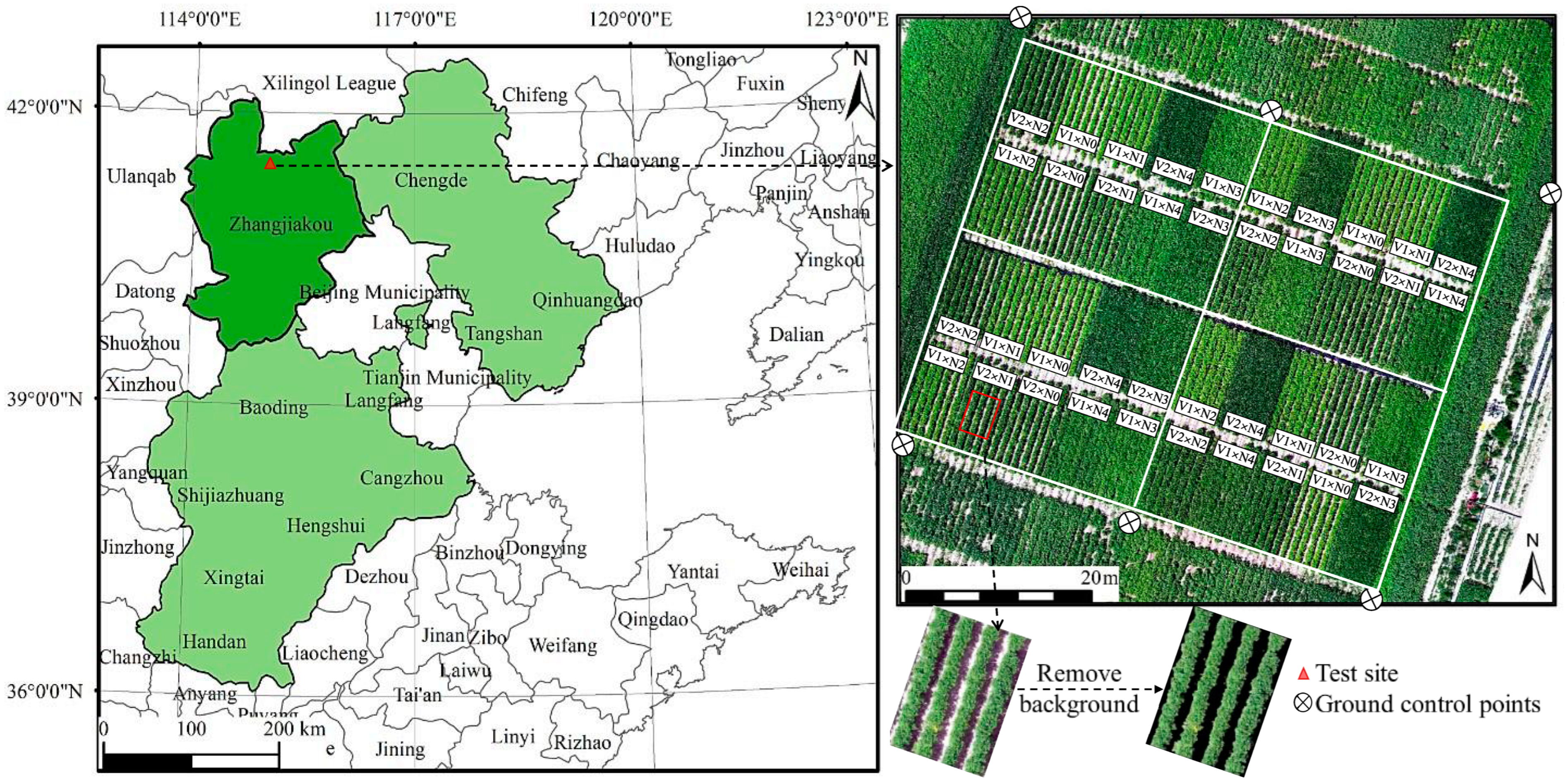
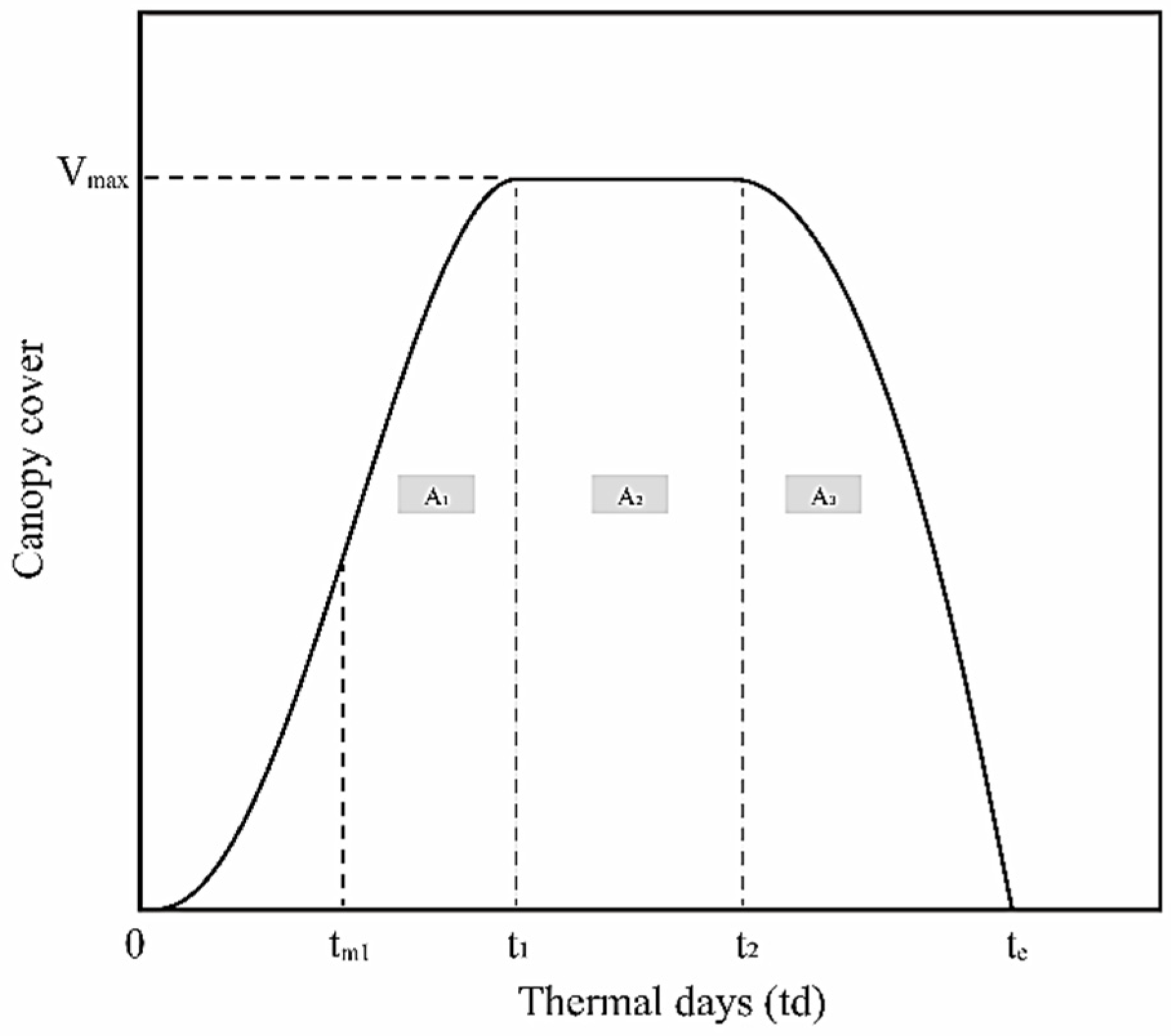
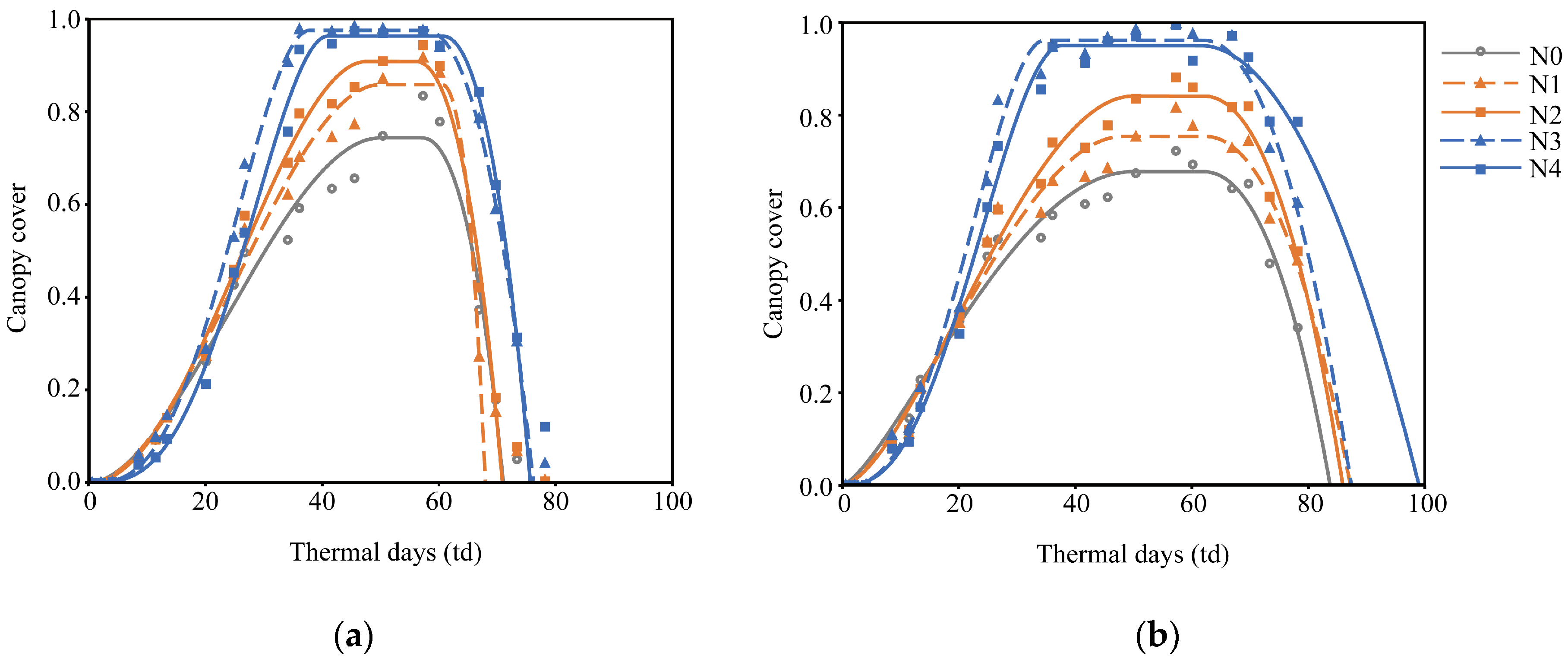
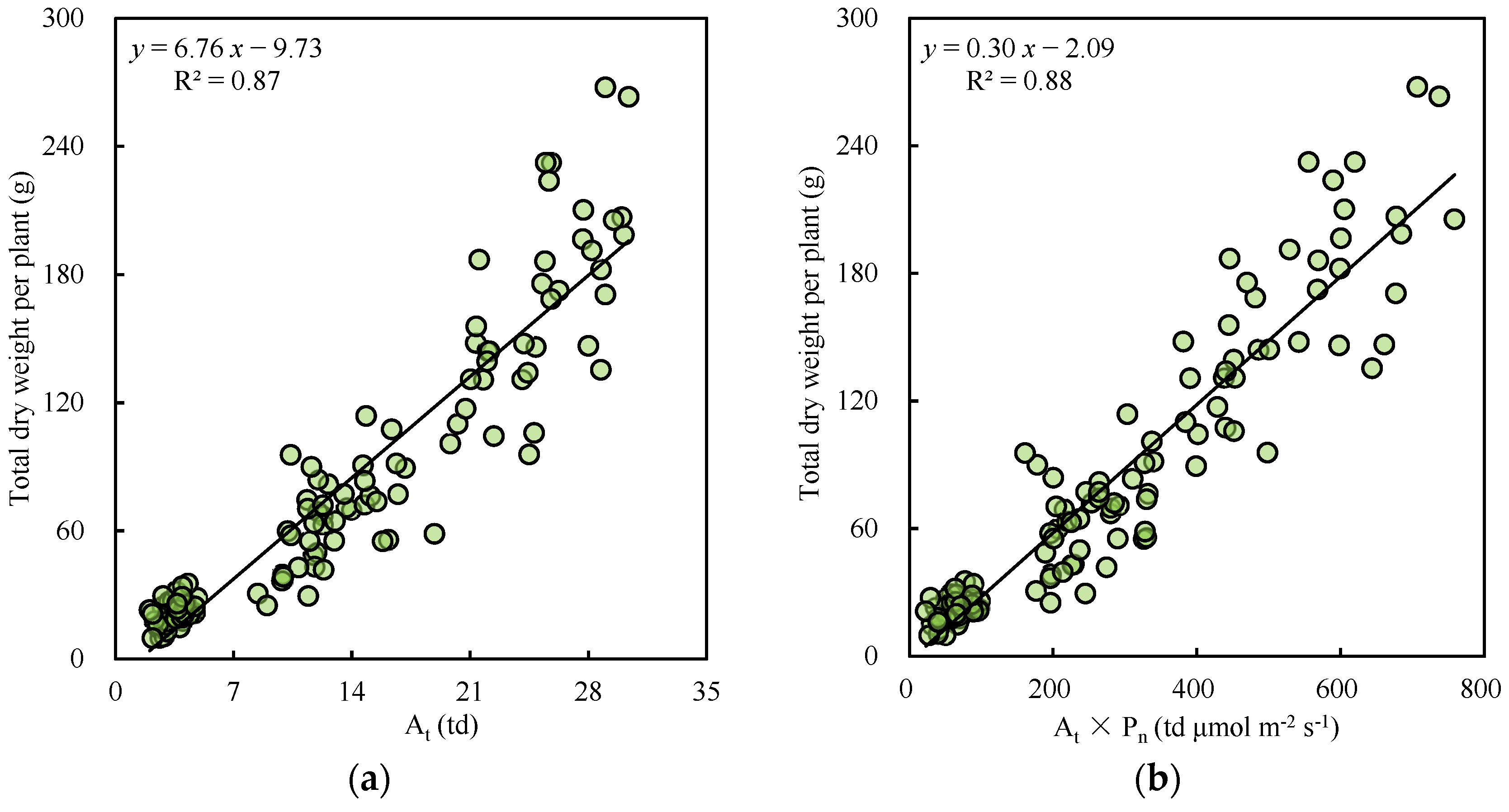
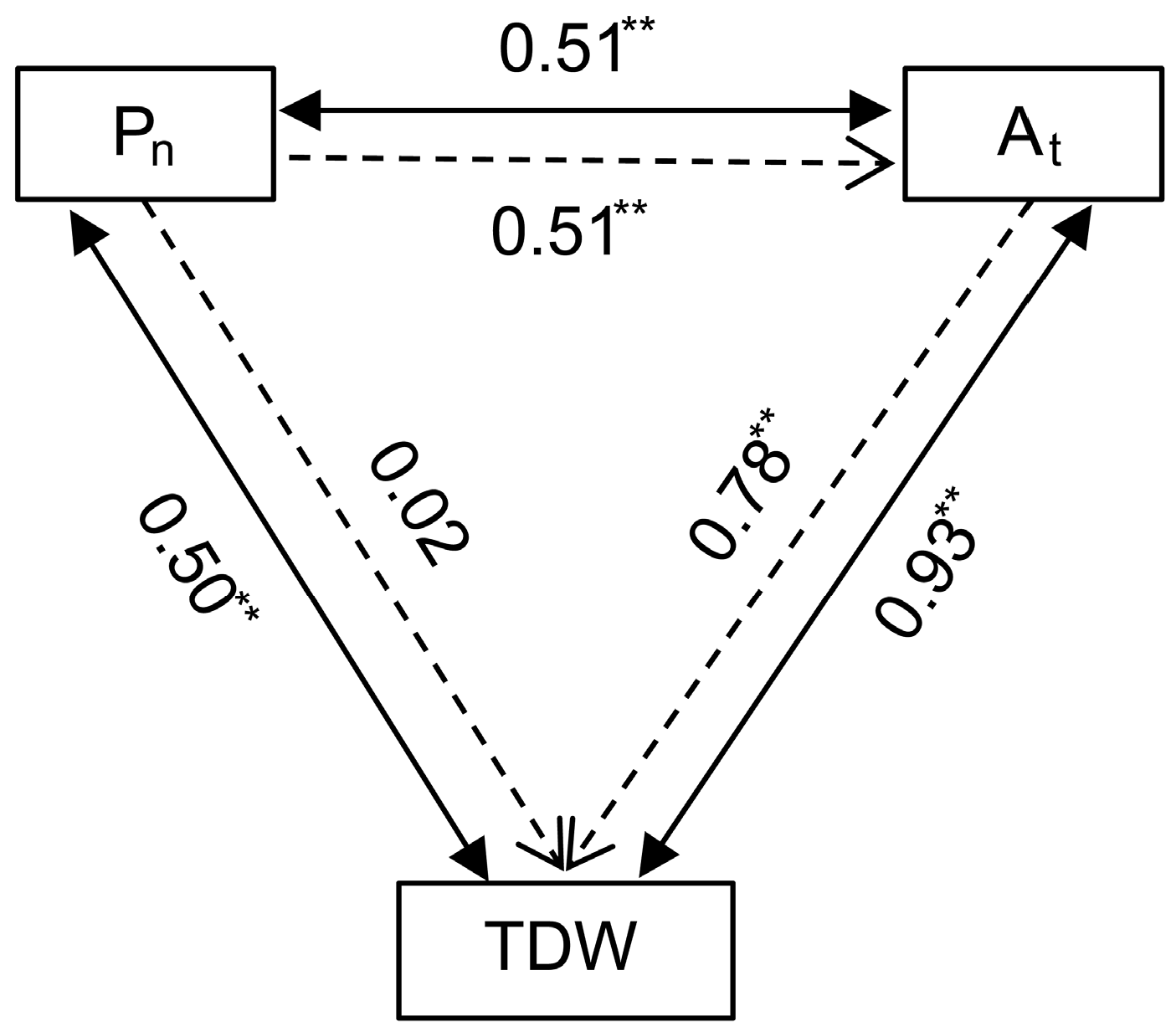
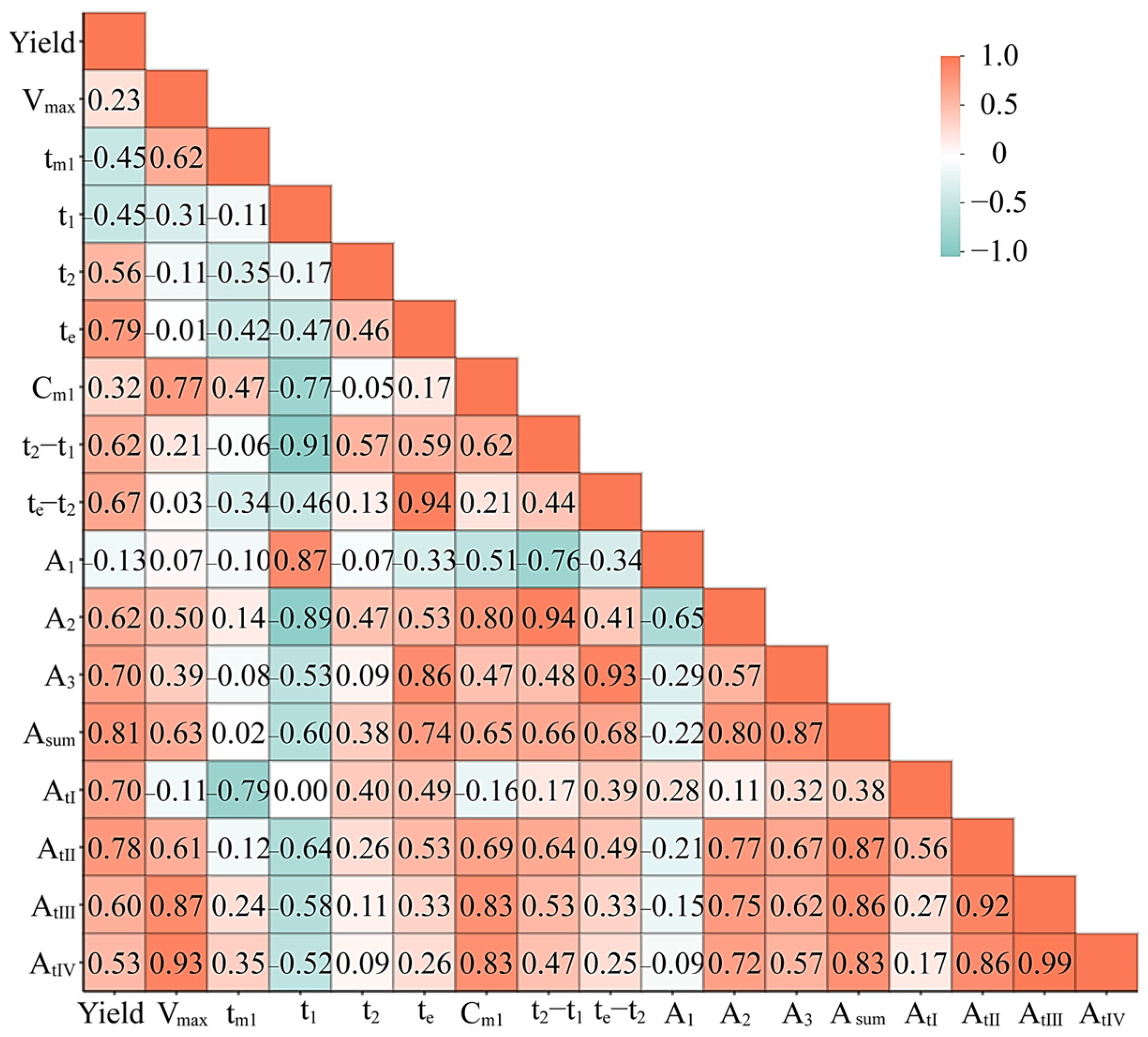
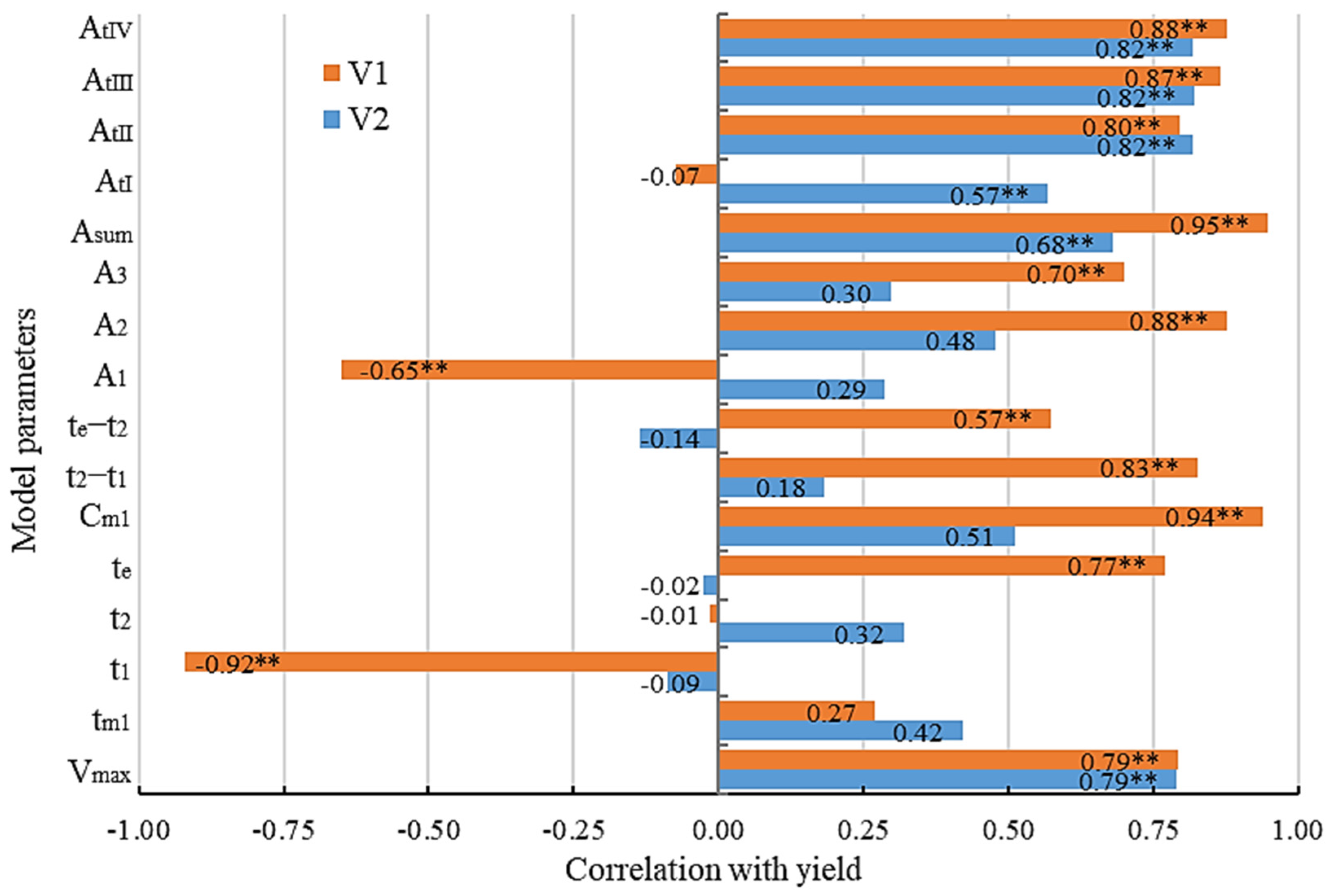
| Varieties | Treatments | Vmax | tm1 | t1 | t2 | te |
|---|---|---|---|---|---|---|
| ‘Shapody’ | N0 | 0.74 ± 0.06 de | 23.76 ± 0.92 bc | 50.00 ± 0.00 a | 58.93 ± 1.21 abc | 70.56 ± 0.95 e |
| N1 | 0.86 ± 0.04 abc | 25.05 ± 1.09 b | 50.00 ± 0.00 a | 59.66 ± 1.89 abc | 69.30 ± 1.92 e | |
| N2 | 0.91 ± 0.04 ab | 25.91 ± 0.81 b | 47.12 ± 1.82 ab | 56.06 ± 0.84 c | 70.89 ± 0.31 e | |
| N3 | 0.98 ± 0.00 a | 25.65 ± 0.73 b | 37.12 ± 1.14 de | 57.90 ± 1.84 bc | 76.26 ± 0.90 d | |
| N4 | 0.97 ± 0.01 a | 28.35 ± 0.21 a | 41.13 ± 0.48 cd | 59.80 ± 1.15 abc | 76.61 ± 1.60 d | |
| ‘Zhongshu 18’ | N0 | 0.67 ± 0.06 e | 15.59 ± 1.21 f | 45.25 ± 2.97 abc | 62.34 ± 1.11 ab | 84.27 ± 1.35 c |
| N1 | 0.75 ± 0.06 cde | 18.82 ± 1.05 e | 44.00 ± 4.06 bc | 63.08 ± 1.45 a | 86.86 ± 0.79 bc | |
| N2 | 0.84 ± 0.06 bcd | 20.09 ± 0.82 de | 48.08 ± 1.31 ab | 61.74 ± 1.92 ab | 89.53 ± 4.27 b | |
| N3 | 0.97 ± 0.01 a | 22.33 ± 0.34 cd | 35.53 ± 2.06 e | 61.59 ± 0.50 ab | 88.59 ± 2.44 bc | |
| N4 | 0.95 ± 0.00 ab | 24.13 ± 0.89 bc | 36.47 ± 1.87 de | 62.91 ± 1.24 a | 96.81 ± 1.94 a |
| Varieties | Treatments | Cm1 | t2−t1 | te−t2 | A1 | A2 | A3 | Asum |
|---|---|---|---|---|---|---|---|---|
| ‘Shapody’ | N0 | 0.02 ± 0.00 cd | 8.93 ± 1.21 e | 11.63 ± 1.80 ef | 19.04 ± 1.62 abc | 6.75 ± 1.23 e | 5.90 ± 0.69 f | 31.68 ± 2.31 e |
| N1 | 0.03 ± 0.00 cd | 9.66 ± 1.89 e | 9.64 ± 3.81 f | 21.48 ± 0.95 a | 8.16 ± 1.48 e | 6.03 ± 2.59 ef | 35.67 ± 1.98 de | |
| N2 | 0.03 ± 0.00 c | 8.95 ± 1.14 e | 14.82 ± 0.84 def | 20.14 ± 0.44 ab | 8.25 ± 1.33 e | 9.42 ± 0.78 def | 37.82 ± 1.76 cd | |
| N3 | 0.05 ± 0.00 a | 20.78 ± 2.48 abc | 18.36 ± 2.02 cde | 13.83 ± 0.64 c | 20.27 ± 2.39 ab | 12.33 ± 1.36 cd | 46.44 ± 1.27 b | |
| N4 | 0.04 ± 0.00 b | 18.67 ± 1.36 cd | 16.82 ± 2.10 cdef | 15.21 ± 0.54 bc | 18.01 ± 1.20 bc | 11.26 ± 1.45 cd | 44.47 ± 1.30 b | |
| ‘Zhongshu 18’ | N0 | 0.02 ± 0.00 d | 17.10 ± 2.93 cd | 21.93 ± 2.24 bcd | 17.46 ± 2.89 abc | 11.00 ± 1.35 de | 10.00 ± 1.23 de | 38.46 ± 3.36 cd |
| N1 | 0.03 ± 0.00 cd | 19.09 ± 4.67 bcd | 23.77 ± 1.00 bc | 17.72 ± 3.25 abc | 13.78 ± 2.76 cd | 12.18 ± 1.32 cd | 43.67 ± 3.51 bc | |
| N2 | 0.03 ± 0.00 cd | 13.67 ± 2.50 de | 27.79 ± 5.42 ab | 21.65 ± 2.04 a | 11.51 ± 2.25 de | 15.14 ± 1.82 bc | 48.29 ± 1.70 b | |
| N3 | 0.05 ± 0.00 ab | 26.06 ± 1.87 ab | 27.00 ± 2.91 ab | 14.58 ± 1.74 bc | 25.18 ± 1.68 a | 17.60 ± 1.74 ab | 57.36 ± 1.45 a | |
| N4 | 0.05 ± 0.00 ab | 26.44 ± 2.82 a | 33.90 ± 1.07 a | 13.97 ± 0.99 c | 25.13 ± 2.73 a | 21.54 ± 0.65 a | 60.64 ± 2.19 a |
| Parameters | Direct Effect | Indirect Effect | Total Effect |
|---|---|---|---|
| Vmax | −0.002 | −0.706 | −0.708 |
| AtII | 0.573 | 1.144 | 1.717 |
| AtIII | 0.131 | −2.206 | −2.075 |
| AtIV | −0.768 | 1.885 | 1.117 |
| Asum | 0.732 | 0.000 | 0.732 |
Disclaimer/Publisher’s Note: The statements, opinions and data contained in all publications are solely those of the individual author(s) and contributor(s) and not of MDPI and/or the editor(s). MDPI and/or the editor(s) disclaim responsibility for any injury to people or property resulting from any ideas, methods, instructions or products referred to in the content. |
© 2024 by the authors. Licensee MDPI, Basel, Switzerland. This article is an open access article distributed under the terms and conditions of the Creative Commons Attribution (CC BY) license (https://creativecommons.org/licenses/by/4.0/).
Share and Cite
Ye, Y.; Jin, L.; Bian, C.; Liu, J.; Guo, H. Monitoring and Optimization of Potato Growth Dynamics under Different Nitrogen Forms and Rates Using UAV RGB Imagery. Agronomy 2024, 14, 2257. https://doi.org/10.3390/agronomy14102257
Ye Y, Jin L, Bian C, Liu J, Guo H. Monitoring and Optimization of Potato Growth Dynamics under Different Nitrogen Forms and Rates Using UAV RGB Imagery. Agronomy. 2024; 14(10):2257. https://doi.org/10.3390/agronomy14102257
Chicago/Turabian StyleYe, Yanran, Liping Jin, Chunsong Bian, Jiangang Liu, and Huachun Guo. 2024. "Monitoring and Optimization of Potato Growth Dynamics under Different Nitrogen Forms and Rates Using UAV RGB Imagery" Agronomy 14, no. 10: 2257. https://doi.org/10.3390/agronomy14102257






